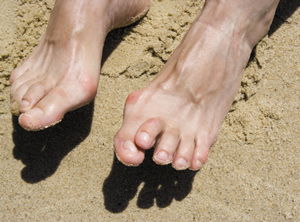
Istockphoto.com #6578642
Predictive variables include race, age
By Emily Delzell
Research presented in July at the annual meeting of the American Podiatric Medical Association in Boston adds to knowledge of risk factors for and prevalence of hallux valgus. Older age, African American race, high heel use, and genetic factors all conferred an increased risk of HV.
“Foot disorders such as hallux valgus deserve more attention because they are so common and can contribute to more serious problems, such as falls, decreased physical activity, limitations in the ability to perform daily activities, and decreased quality of life,” said Yvonne Golightly, PT, PhD, a postdoctoral fellow at the Thurston Arthritis Research Center at the University of North Carolina at Chapel Hill.
A cross-sectional analysis described racial differences in the prevalence of foot disorders in a cohort of men and women aged ≥50 years (1536 participants, mean age 69 years, mean body mass index [BMI] 31.5 kg/m2, 68.4% women, 30.3% African American).
Of the foot disorders researchers identified with the Foot Assessment Clinical Tool, HV was the most common, affecting 62.8% of participants.
“In nonobese individuals, African Americans were almost two times more likely than whites to have hallux valgus. But in obese participants, prevalence was just as high in whites as in African Americans. This difference seen in the non-obese suggests a real racial difference,” said Golightly, the study’s lead author.
Race wasn’t looked at in three sets of findings based on data from the Framingham Foot Study, a prospective population-based cohort study of more than 2000 ambulatory community dwelling adults. But one analysis of the Framingham data found that BMI >30 was protective against HV, a finding that surprised lead author Marian Hannan, MPH, DSc, an associate professor of medicine at Harvard University and co-director of musculoskeletal research at the Institute for Aging Research, Hebrew SeniorLife, in Boston.
“From a structural load perspective, this is opposite of what one might expect to find,” Hannan said.
The risk factor research also found that older age and foot pain increased HV risk in women by 20% and 36%, respectively, and 20% and 81% in men. Overall, the study found that 20% of men and 41% of women (mean age 67±10.6 years) had HV.
Past high heel use increased HV risk by 22%. Investigators defined past use as participants’ self-reported primary shoe type during 10-year periods beginning when individuals were aged 20 years.
“We found what we expected, that past—but not current—high heel use was predictive of hallux valgus. Women reported wearing high heels the most when they were aged 20 to 29, and high heel use diminished each decade until people reached 60, when wear really plummeted. It makes sense that people with hallux valgus and foot pain are uncomfortable in heels and are less likely to be current wearers,” Hannan said.
For a potential explanation of the unexpected protective effect of obesity, Hannan pointed to another of the Framingham-based studies.
The study showed that HV heritability overall was 39% for women and 38% for men (mean age 66 years, age range 39-99 years), but was significantly increased in the subset of participants younger than 60 years (HV heritability, 89%).
“We know that genes for obesity are also highly heritable and it could be that the gene for hallux valgus is linked to obesity genes,” Hannan said.
The third set of findings based on Framingham data looked at foot disorder epidemiology, and found that HV was the most common foot condition. Investigators assessed 2231 participants for 20 foot conditions; 92% had some kind of disorder and 39% had HV.
“The purpose of this study was to look at the general population versus what’s seen in clinic settings, where prevalence of disorders varies greatly depending on the clinic’s specialty,” Hannan said.








